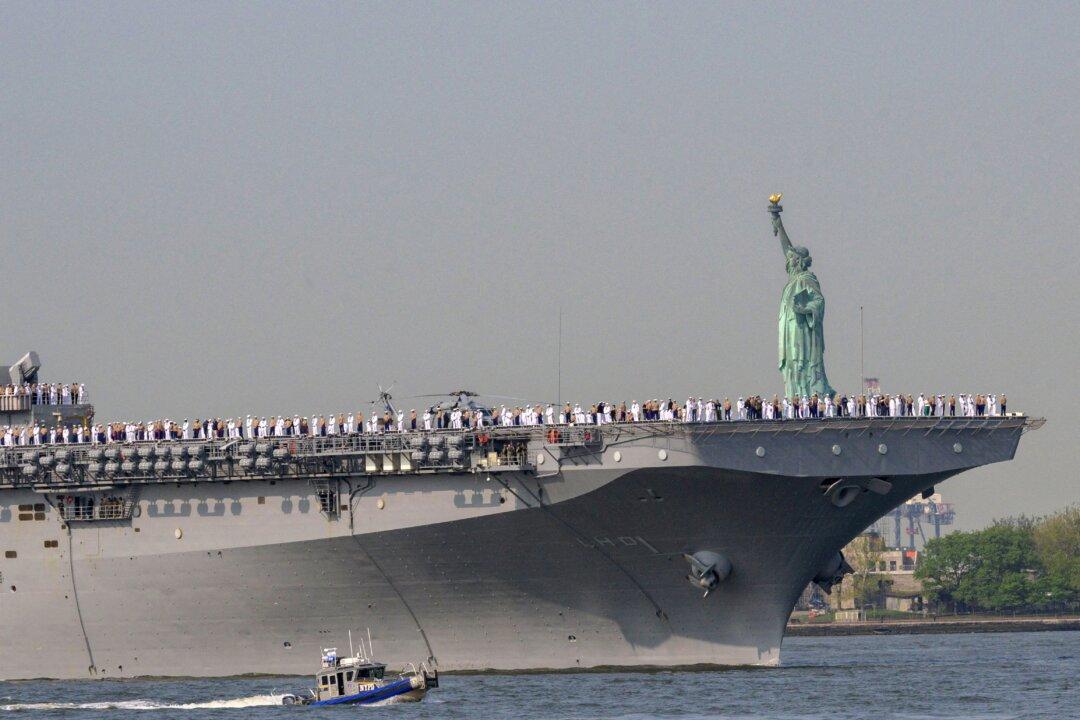Beijing’s hoarding of ships’ geolocation data is another indicator of its future plans to use commercial shipping for military purposes. The United States and allies should demand more transparency.
China’s shipping fleet is going dark, potentially endangering maritime transport, and causing major problems for supply chain managers and shipping coordinators as they struggle to map shipping flows in Chinese ports with insufficient data. Beijing is supposedly imposing the blackout due to national security concerns, which indicate that it will continue to illegally use its commercial shipping fleet for military purposes. But the ship geolocation blackout could also help China’s huge illegal fishing fleets.
AIS provides geolocation data to the world’s public for ship safety, tracking, and logistics. When Beijing instead turns off China’s AIS shore-based receivers, and ship-based transponders, to facilitate military aggression or the theft of economic resources in another country’s EEZ, it is not only unethical, but sometimes a violation of the U.N. Convention on the Law of the Sea.
Restricting access to AIS data effectively restricts public knowledge of state-sponsored criminality.
Beijing Degrades Its Provision of Commercial Maritime Data
The quantity of AIS data that geolocate ships near China and is distributed to foreigners has plummeted due to espionage fears that are apparently driving the crackdown by the CCP. Fixed-point terrestrial AIS receivers on China’s coastline and interior waterways, which used to transmit the locations of nearby ships dozens of times per minute, are now mostly dark. This is forcing the international community to rely on satellite data that only provides the locations of a subset of the best-equipped ships, much less frequently.Cichen Shen of Lloyd’s List noted in an article that “China is still capturing all the AIS signals albeit not sharing them.”
He believes that the continued AIS “data gap could cause headaches and dangers for foreign companies trying to monitor their fleet or the underlying trade flows in Chinese waters because of a loss in visibility.”
The failure to provide foreign shipping companies with an even playing field will put them at a disadvantage in Chinese shipping markets, and is arguably a violation of World Trade Organization rules.

Beijing Thinks Spies Are Using Its Data
The culprit, according to Cichen Shen, is a new Personal Information Protection Law that took effect on Nov. 1. He described it as “part of China’s legislative efforts to control how and whether its sovereign data can be accessed by domestic and foreign organisations.”The Times cited Chinese state media that warned, about AIS stations in coastal Guangdong, that the “intelligence extracted from this data endangers China’s economic security and the harm cannot be ignored.”
The Dramatic Drop in Chinese Ship Data Transmissions
Lloyd’s List noted that Chinese data providers are shutting down their AIS transmissions to foreigners just in case they could be considered in violation of the new rules. It reported, for the first week of November, 12 percent fewer AIS positions recorded in China’s EEZ, which normally extends 200 nautical miles from the shoreline.International shipping supply chain managers will now find it more difficult to plan shipping routes, logistics, and throughput in Chinese ports. But if the ban expands further, it could seriously endanger shipping and violate Beijing’s international commitments. China’s allies could follow, extending the degradation of previously freely available shipping data globally.
Already, according to Greg Poling, a maritime law expert at the Center for Security and International Studies, “Vietnam doesn’t feed much shore based AIS data to the commercial providers so in its waters we’re wholly reliant on satellite.”
According to Professor James Kraska, who has dual appointments at the U.S. Naval War College and Harvard University, “AIS is the primary means” of visibility into global ship movements, and is required by the International Convention for the Safety of Life at Sea (SOLAS) for ships of at least 300 gross tons (GT). He said that “turning it off makes maritime domain awareness more challenging.”
Most Chinese ships near Chinese shores have kept their AIS transponders on, according to Poling.
The transponders, also known as transceivers, can receive and send geolocation data. This makes them visible to satellites and able to broadcast their positions to other nearby ships.
But some ships use weak transmitters that can only be seen by the shore-based, not satellite, receivers.

As Beijing is turning off China’s AIS data flows to foreigners at a more systematic level, international shipping managers must send shipments in and out of Chinese ports with less information about local maritime traffic conditions than they had previously done. Academics and non-profits concerned about overfishing and Beijing’s subsidized and militarized fishing militia, will have less data necessary to track and publicize Beijing’s transgressions.
There is no theoretical reason for Beijing to stop the Chinese data ban at terrestrial AIS. It could almost as easily, in the name of national security, limit the transmission of its shipping industry’s maritime locations transmitted by satellites or the ships themselves, anywhere in the world.
While the AIS transmitters of Chinese shipping have in general not been shut off to foreign receivers, this is a possibility that should be planned for given deteriorating relations between Beijing and most of the rest of the world, and the CCP’s sledgehammer approach, where a scalpel might have sufficed.
China’s AIS Blackout Is Not Dangerous, According to Experts
“The blackout imposed by the PRC [People’s Republic of China] deals with the relay and transmission from shore of AIS data,” Dr. Mercagliano wrote. “Ships are still broadcasting and any vessel can query another so there is no concern about navigation hazard. What happens with AIS, is that there are shore operators that have receivers that gather the AIS data.”Chinese shore-based receivers have in the past shared the AIS data they collect with international data aggregators such as Marine Traffic, IHS Markit, and Windward, according to Poling.
Now those data sources have less data. “The issue is the quality of info,” wrote Salvatore. “The loss of this data makes it difficult for freight forwarders and shippers to track cargoes and coordinate elements of the supply chain.”
Poling wrote that “the reason the AIS blackout isn’t a threat to safety of navigation is that the ships haven’t actually stopped broadcasting.” And that “Chinese authorities have just banned the sale of shore-based AIS to commercial firms abroad.”
The shore-based receivers and harbor masters still see the vessels, according to Poling. The vessels can also see each other when they are within range, which varies depending on the quality of their transmission and reception devices.
That the China shore-based data is now hoarded instead of shared with international data aggregation platforms “makes it moderately harder for shipping companies and insurers to track their ships when they’re near the Chinese harbors for purposes of planning logistics and the like (but they can see them fine everywhere else by satellite),” Poling wrote, “and it makes it a little harder for those of us in academia to keep an eye on Chinese activity (but again, we still have satellite-based and the shore based data from all the other coastal states).”
Poling acknowledged that individual Chinese ships could turn off their AIS transmitters, but claimed that there was no systematic evidence of them doing so. He said that China’s navy and coast guard are under no legal obligation to keep their AIS on, so they could go dark on occasion.
“But we don’t see evidence that the commercial boats or [Chinese maritime] militia systematically turn the[m] off. The reason they disappear from commercial platforms as they get farther from China’s coast is that most of them are equipped with weaker Class-B transceivers, not the Class-A required by the IMO [International Maritime Organization] for international transit.”
Chinese Shipping That Goes Dark Increases International Tension
Decreasing visibility of commercial ships near China is a self-imposed casualty and follow-on effect of Beijing’s increasing military aggression. As part of this aggression, the CCP has attempted to hide its military activities behind steel-reinforced fishing boats that are in fact a maritime militia and extension of the Chinese navy.
However, democracies are on to this ruse, and developing new ways to identify which of China’s thousands of fishing boats are associated with the maritime militia, and which are not.
Poling’s own research, conducted with coauthors Tabitha Grace Mallory, Harrison Prétat, and in conjunction with the Center for Advanced Defense Studies, has used AIS data as indicators of a particular ship’s membership in the militia.
Beijing was likely not amused. Its original use of fishing boats, militia, and other naval assets for aggressive purposes caused a higher level of international scrutiny, including academic examination of AIS data from militia vessels, which Beijing in turn called espionage. That national security justification led to Beijing’s overdone InfoSec that will make imports and exports to China more difficult.
Lloyd’s List coverage of the AIS blackout cited an espionage case in the shipping sector that “has added to the concerns” of Chinese data providers that is leading them to cut off their data transmissions in anticipation.
“An unnamed ‘foreign consultancy’ was said to have been caught by [the] state security department in May to provide its compatriot ‘spy agency’ with shipping and cargo data obtained from its Chinese business partners,” according to Lloyd’s.
When asked whether his research and prior studies had caused Beijing’s crackdown on terrestrial AIS in China, Poling replied, “I think it [is] likely that the whole body of work from us and others in Vietnam probably contributed to the national security rationale. But I think the proximate trigger early this month (before anyone in China knew about our report) was the new information security law.”
Thus the United States, China, and their allies appear to be in a classic downward spiral of insecurity and fears of exactly the type that increase the chance of military conflict.
“What the PRC has just done is bad, goes against global trends of best practices and progress, and is part of larger ill winds of opacity and undermining of international rules and norms under Xi [Jinping],” according to one U.S. military source who asked to remain anonymous.
China’s aggression and fear are economically decoupling itself, or worse, in an erosion of the international system of trade that could be an own goal of epic proportions, and part of a downward spiral of mutual suspicion toward military conflict.





